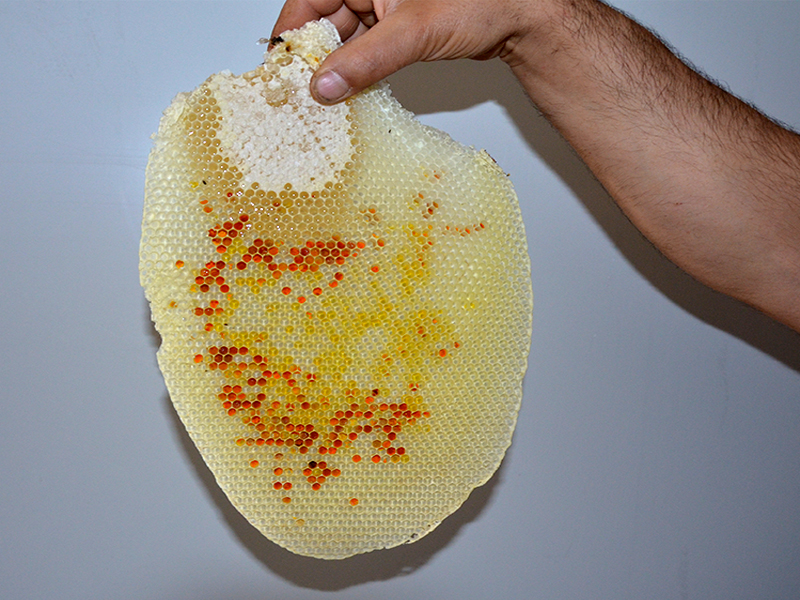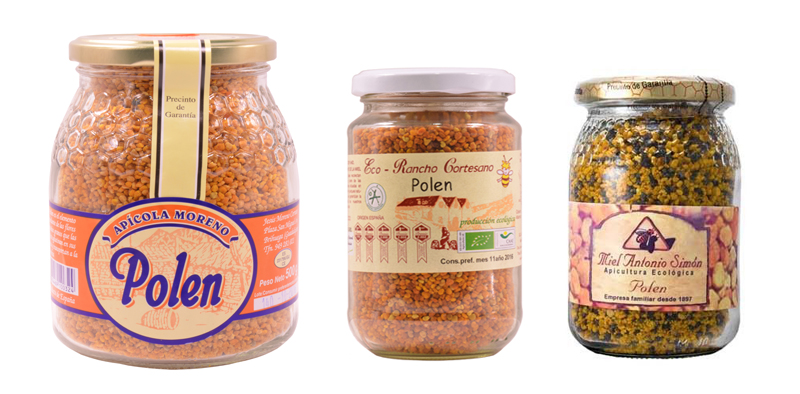Bee pollen
Bee pollen is a fantastic food that everyone should eat, as it provides us with all the ingredients our body needs. It is a natural food that comes from the flowers of plants and thanks to bees, we can easily collect it. Therefore, another of the foods that bees provide us with, apart from their honey.
Index:
|
Summary: Pollen is a product that comes from plants and is collected by bees. In our shop in Las Rozas de Madrid you will also find organic and conventional pollen from Guadalajara, Cádiz and Madrid.
Related articles: Where to buy raw honey? Raw unpasteurized honey
1. What is pollen?
Pollen is the male element of flowering plants, which occurs in the form of microscopic grains inside the anthers of stamens. Under a degradation-resistant envelope, pollen contains essential nutrients, which are used by bees for food. Therefore, this is the pollen found on flowers that many people are allergic to.
The bees collect this pollen, transport it in granules, and once it arrives in the hive, they smear it with saliva, and the pollen loses its ability to germinate on the stigma of the flowers. Once it has undergone this process, we begin to call this natural product bee pollen.
a) Bee pollen
Pollen from flowers is collected by bees. They transport it to the hives to feed the hive. However, man puts trap doors at the entrance of the hive, so that the pollen transported by the bees falls into them. This is the bee pollen that is sold by beekeepers or can be found in specialised honey shops. You can also buy it fresh or dried. Fresh pollen will logically have more beneficial properties for your health.
b) Bee bread
If the pollen does not fall into the cells of the hives, the bees carry out the following process. First, the collected pollen is put into the cells of the honeycomb. Once inside, they add their own enzymes and a layer of honey per oak. Finally, they close the cell with beeswax.
The pollen here undergoes a lactic transformation, losing its ability to germinate, increasing its bactericidal power and its nutritional value. Its nutritional value increases threefold. This product is what we call bee bread.
c) Collection
Beekeepers use different traps to collect pollen. These traps are used to prevent the pollen from reaching the inside of the hive and to avoid having to use other methods to extract the pollen.
Among the traps we have fixed traps that are placed inside the hive or removable traps, the latter being placed outside, in front of the entrance to the hive. The function of the trap is to catch the pollen before it enters the hive.
The trap consists of a grid, and underneath this a box where the pollen accumulates. As the bees have to pass through the grid, they drop the pollen, so that much of the pollen does not get into the hive.
2. Composition of bee pollen
Pollen is a very important food source because it contains the following nutrients:
- Amino acids: among them, the most important are glutamic acid, aspartic acid, leucine and lysine.
- Carbohydrates: sugars, starch, pectin, etc.
- Lipids:
- Minerals: K, Na, Ca, Ca, Mg, N, P, S, Al, Cu, Cu, Fe, Mn, Ni, Ti, Zn, etc.
- Resins and sterols
- Vitamins: B. C. D. E. and provitamin A.
- Enzymes and antioxidants.
These are all nutrients needed by the human body. Therefore, with only water and pollen we could live perfectly well.
Below is a detailed study of some of their components:
a) Amino acids:
Pollen is one of the few natural compounds that contains all amino acids, including the 10 essential ones. Essential amino acids cannot be synthesized by the body, so it is essential that they be incorporated into the diet.
b) Minerals:
Among the minerals contained in pollen, the good amount of calcium and organic iron stands out, as they are easily absorbed and assimilated. Organic calcium goes directly to form bone, compared to mineral calcium that stays in the bloodstream until it is removed, usually in the form of stones. Another mineral that contains pollen is selenium, magnesium, together with flavonoids, all of which have antioxidant effects.
c) Vitamins:
Pollen also contains all vitamins except vitamin A. However, in pollen there is a large amount of carotenes, which perform the function of provitamin A, and this is transformed during digestion into vitamin A..

Photo 1: Honeycomb full of pollen
d) Other components:
Pollen, like royal jelly, contains 10-Hydroxydocenoic acid, an antiseptic and immunomodulatory component that has an anti-inflammatory effect on the prostate, helping to relax and reduce inflammation of the prostate.
3. Properties of fresh and granulated pollen:
Pollen, being one of nature’s most complete foods, can be used to treat the following diseases:
|
|
|
|
|
|
|
|
|
|
|
a) Cardiovascular problems
Pollen also contains fiber, helping to improve intestinal transit. In addition, pollen contains phytosterols (vegetable fats) and these together with polyunsaturated fatty acids promote the control of cholesterol metabolism, lowering LDL, the so-called bad cholesterol and raising HDL, the so-called good cholesterol.
b) Diabetes:
Diabetics must have a very restricted diet, avoiding many foods. This restriction can lead to these people suffering from nutritional deficiencies. As a consequence, the consumption of pollen is ideal for people, as it provides all the nutrients that the human body needs and at the same time, because it has a very low sugar content.
c) Indigestion, diarrhea, or other digestive problems
Pollen fiber improves intestinal transit. In addition, pollen contains 10-hydroxydocenoic acid, an antiseptic and immunomodulatory component that acts against bacterial diarrhoea.
d) Obesity and weight loss
Pollen contains lecithin. Lecithin helps remove fat from the body by increasing metabolism. Lecithin also creates a feeling of satiety. When we feel full, we don’t eat between meals, we eat less food, and as a result, we lose weight.
Together, this weight loss does not lead to malnutrition, because pollen is a very complete food that provides us with all the necessary nutrients.
e) Prostate and prostate cancer:
The hormonal, vitamin and trace element content has a rejuvenating and anti-inflammatory effect on the prostate. Numerous studies corroborate this information, although the mechanisms that produce an increase in prostate size are not yet known, although the sex hormone testosterone plays an important role in this process.
f) Allergies:
Pollen consumption can have an immunizing effect against allergies. According to different scientific articles, you could cure your allergy by taking a few grains a day and over the days, increasing your dose to one tablespoon a day. In this way, the body would no longer consider pollen as an invasive foreign body and would be immunized. At the same time, pollen can reduce the amount of histamine in the body, and thus reduce the effects of allergies.
Video 1: Various pollen pots from Spain
g) Low energy or fatigue:
It increases the energy of the body by containing a high concentration of B vitamins, proteins and amino acids.
h) Vision:
Pollen contains a large amount of provitamin A, which is converted in digestion into vitamin A. Vitamin A is necessary for good vision and night vision.
i) Rheumatism or arthritis:
It contains organic calcium of easy absorption and assimilation that goes directly to bone formation.
j) Depression:
Pollen contains tryptophan, an amino acid with a chemical structure similar to serotonin. Serotonin is a chemical produced by our body that is responsible for our mood, so an increase in serotonin reduces depression.
k) Anti-carcinogenic:
Pollen contains antioxidants that neutralize free radicals that form in the body and can damage lipids. Proteins and nucleic acids (DNA and RNA) and induce cancer.
4. How to take fresh pollen
Pollen should be consumed on an empty stomach about 10 minutes before breakfast. To digest it, take a tablespoon directly or dissolve it in water. Pollen can be consumed throughout the year without interruption, although some doctors recommend taking a break from time to time.
The recommendation is to take it on an empty stomach, but apart from taking it only in the morning, we can also take it mixed with other foods. It is also delicious and nutritious when mixed with yogurt, milk or salads.
Another ideal time to consume it is before meals, as it contains lecithin and will satisfy us. As we are more satiated we will have less desire to eat, therefore we will consume less calories and we will be able to lose weight.

bee pollen
Picture 2: Dry pollen
5. Does bee pollen make you fat?
Pollen, like other foods, contains fatty acids, proteins and carbohydrates. However, due to the small amount of pollen we can consume each day, it will not have any influence on the calories ingested.
On the other hand, as pollen is a food with all the nutrients a human being needs, it provides the body with all its nutritional needs. In this way, our mind will not ask us for more than it needs and it will help us to lose weight. Pollen also contains lecithin, which satiates us. If we are satiated, we eat less food and therefore lose weight.
Therefore, if you want to lose weight, we recommend taking a spoonful of pollen within ten minutes of any meal.
6. How to preserve bee pollen?
When preserving bee pollen we have to take into account the type of pollen we have.
Fresh bee pollen: This bee pollen has a high percentage of humidity, for this reason it should be kept in the same closed jar in the fridge. Close the jar so that it does not pick up strange flavours from the fridge. Also, if we are going to consume it for more than a month, we can put the pollen in the freezer for better preservation. Due to the humidity and the richness of nutrients, the pollen can catch fungus.
Dried bee pollen: For this type of pollen we should keep it in a cool place away from light sources. We recommend respecting the expiry dates of pollen, as some of its components can go rancid.
7. Price of bee pollen
The price of bee pollen has risen considerably in recent years, due to unfavourable weather conditions.
Sources:
Apiroterapia hoy. En Argentina y Cuba Dr Julio cesar Díaz.
http://www.postindependent.com
A Critical Review of Graminex Flower pollen extract for Symptomatic Relief Of Lower Urinary Tract Symptoms (LUTS) in Men Walter G. Chambliss, Ph.D
A Critical Review of Cernitin for Symptomatic Relief Of Lower Urinary Tract Symptoms (LUTS) in Men Harry G. Preuss1 Debasis Bagchi2 Walter G. Chambliss3







Leave a Reply
Want to join the discussion?Feel free to contribute!